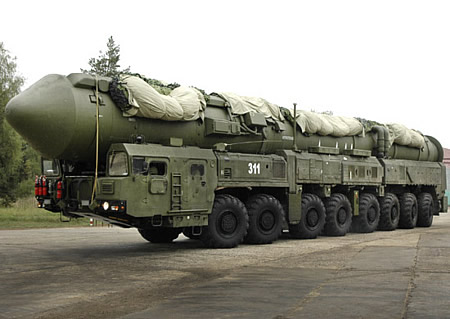New Nuclear Notebook: Russian Nuclear Forces 2012
 |
| More than two-thirds of Russia’s current ICBM force will be retired over the next 10 years, a reduction that will only partly be offset by deployment of new road-mobile RS-24 Yars (SS-27 Mod 2) ICBMs such as this one near Teykovo northeast of Moscow. |
.
By Hans M. Kristensen
Russia is planning to retire more than two-thirds of its current arsenal of nuclear land-based intercontinental ballistic missiles by the early 2020a. That includes some of the most iconic examples of the Soviet threat against the United States: SS-18 Satan, SS-19 Stiletto, and the world’s first road-mobile ICBM, the SS-25.
The plan coincides with the implementation of the New START treaty but significantly exceeds the reductions required by the treaty.
During the same period, Russia plans to deploy significant numbers of new missiles, but the production will not be sufficient to offset the retirement of old missiles. As a result, the size of Russia’s ICBM force is likely to decline over the next decade – with or without a new nuclear arms control treaty.
This and much more is described in our latest Nuclear Notebook published in the Bulletin of the Atomic Scientists.
This publication was made possible by a grant from Carnegie Corporation of New York and Ploughshares Fund. The statements made and views expressed are solely the responsibility of the author.
Without information, without factual information, you can’t act. You can’t relate to the world you live in. And so it’s super important for us to be able to monitor what’s happening around the world, analyze the material, and translate it into something that different audiences can understand.
Russia currently maintains nearly 5,460 nuclear warheads, with an estimated 1,718 deployed. This represents a slight decrease in total warheads from previous years but still positions Russia as the world’s largest nuclear power alongside the United States.
Nuclear weapons budgeting is like agreeing to buying a house without knowing the sales price, the mortgage rate, or the monthly payment.
The United States Air Force has forward deployed about one-third of its B-2 stealth bombers to Diego Garcia, or about half the B-2s considered fully operational at any given time.